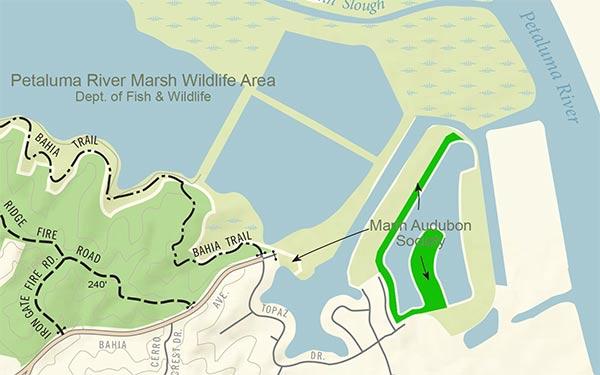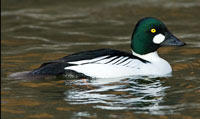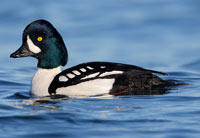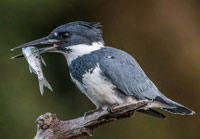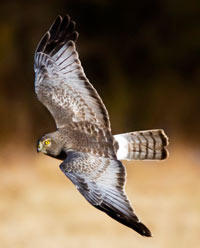Bahia Lagoon, Novato
- Jack Gedney, December 16, 2015
Bordering the Bahia neighborhood in northern Novato, the main area of interest discussed here is the “East Lagoon” or “Horseshoe Pond” found on the right side of this map. Note that public access areas are marked in green; see bottom for more specifics on location and access. |
|
|
Marin Audubon Society’s restoration project at the Bahia wetlands in northern Novato is an underappreciated birding site that escapes many birders’ notice due to its small size, out of the way location, and independence from the larger and more well-known systems of parks and open space preserves in the North Bay. While the neighboring tidal areas surrounding the nearby Rush Creek Open Space Preserve host large numbers of ducks and shorebird, Bahia’s smaller East Lagoon offers a slightly different habitat, with a non-tidal pond surrounding by open fields with only scattered trees. (Though many young oaks and other upland plants have been planted in Marin Audubon’s ongoing restoration work). This yields a somewhat different mix of species, with the lagoon a special hotspot for some less common local birds. First the ducks. The stars of the Bahia lagoon are the large flocks of common goldeneyes that build up in winter to hundreds of birds. These elegant ducks mix with scaups and their much less numerous cousins the Barrow’s goldeneye. Look closely for the bold white crescents in front of the eyes (vs. round circles on common goldeneye) on the male Barrow’s to distinguish them. Other common ducks on the lagoon include buffleheads, ruddy ducks, and mallards. Bahia is also a good site for mergansers, including both hooded and red-breasted mergansers. You can also expect to see the not-duck American coots and the assorted smaller grebes: the pied-billed grebe all year round and the similar eared and horned grebes in winter. Neighboring tidal or winter-inundated areas host additional duck species such as northern pintail, canvasback, northern shovelers, American wigeon, and green-winged teal. For waterfowl viewing, be aware of the strong seasonal pattern of these species: in summer you are unlikely to see much other than a few mallards, gadwalls, and pied-billed grebes. Additional species begin to appear in September, and then the starring goldeneye tend to be a little on the later side, not really becoming abundant until November through February. This winter period is also the best time of year for raptors, shorebirds, sparrows, and a few other songbirds, so plan accordingly! Beyond ducks and shorebirds, two other particularly interesting local species are closely tied to the water: the Bonaparte’s gull and the belted kingfisher. Bonaparte’s gulls are one of the most distinctive of their family, with a small, agile, tern-like profile and exciting hunting method, diving from the air to grab their prey from under the water surface. Up close, look for a small black dot behind their eye, but even at a distance you can recognize them by their smaller size and active flight style. The belted kingfisher is similarly engaging to watch, hovering and plummeting towards the water when they sight their prey. Multiple kingfishers are regular in the area around the lagoon and it is always a pleasure to see their striking and cartoonishly oversized heads even when simply perching. They can often be heard before they are seen—listen for their distinctive rattle call. There are also a few small songbirds that specialize in marsh habitats: look for song sparrows (and, in winter, their less common cousin the Lincoln’s sparrow), marsh wrens, and the atypical warbler the common yellowthroat near the water, hiding among the pickleweed or venturing up into a coyote bush. The adjacent grassy fields host western meadowlarks, savannah sparrows, and Say’s phoebes in winter. The open fields around the lagoon are attractive to a variety of raptors, especially in winter: northern harriers, white-tailed kites, red-tailed hawks, and American kestrels can usually be found somewhere in the surrounding area with a careful scan of the available perching spots. Less common winter raptors include visits from peregrine falcons or the small but powerful merlin. At dusk, barn owls may be seen cruising slow and silent over the fields. You can see many of these birds in an excellent video produced by Jeffery Martin in association with Marin Audubon Society on their Bahia Wetlands page. |
Male Common Goldeneye - Look for the white circle on cheek and white sides with thin black lines |
|
Male Barrow's Goldeneye - Look for the white crescent on cheek and black back with white squares |
|
|
Belted Kingfisher by Andy Morffew |
|
|
Male Northern Harrier - Look for distinctive white rump patch and low coursing flight |
|
To reach Bahia, take the Atherton exit off 101 in northern Novato. Travelling east on Atherton, turn left on Bugeia Ln, which turns into Bahia Dr. At the end of Bahia Dr, turn right on Topaz and continue to the end, where you can park near the club house. We recommend a leisurely loop or two around the inside of the horseshoe, or you can walk out and back along the straight peninsula paralleling the PG&E towers. Either walk can be completed in under an hour. Please note the areas of public access indicated on the signs and on the map above: one side of the lagoon is kept off limits to protect wildlife and ensure the success of the ongoing restoration efforts. If you would like to get involved in Marin Audubon's restoration project, volunteer work days are held on the second Saturdays of each month—see their website.
- Go to Birding Sites Homepage -


